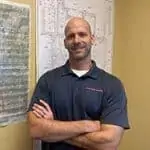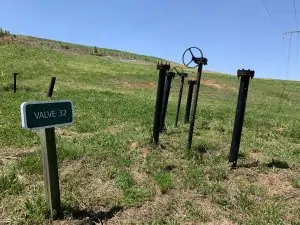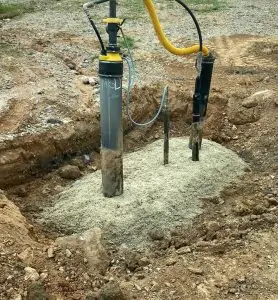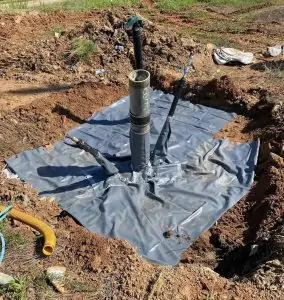

SCS’s Mike Miller explains the impact of the new ASTM E1527-21 Due Diligence Standard. Mike covers the history, CERCLA, defenses, and the changes impacting due diligence in the new Standard in this video. Watch it here. Use chapters in the timeline to jump from topic to topic at these start points:
Learn more about Environmental Due Diligence and All Appropriate Inquiries, and meet Mike Miller, SCS’s National Expert. Today’s commercial real estate transactions must take environmental issues into consideration. Complex laws can impose significant environmental liabilities on purchasers, sellers, and lenders, whether or not they caused the problem, and whether or not they still own the property. Environmental Engineers can help protect you and your investment.
Recent changes to regulatory guidance in California are arguably making obtaining closure on sites with vapor intrusion health risk concerns more difficult to achieve. The Draft Cal-EPA Supplemental Vapor Intrusion Guidance (DSVIG) suggests changes to the methods in which vapor phase transport and potential health risks are modeled and calculated for occupants of buildings with known soil or groundwater contamination beneath them. These changes, which result from a multi-year working group collaboration, recommend a more extensive and site-specific data collection effort. They include indoor air quality calculation methods relying on EPA work and guidance and empirically derived attenuation factors (AFs) which some would argue lead to overestimating potential health risks.
The consequences of the DSVIG are potentially significant if adopted as is and appear likely to result in more sites being “screened in” with vapor intrusion issues and more sites requiring mitigation. The impact, resultant costs, and possibly detrimental secondary effects include decreases in affordable housing production, particularly in urban infill areas. And while none would argue with appropriate protection of health risk, the question is whether the studies and empirical data used to support the DSVIG represents the best available science and is truly representative and predictive of risk.
The DSVIG adopts an attenuation rate of 0.03 for the flux of both soil and sub-slab vapor to indoor air based on a previous 2012 EPA Study comprised of empirical data collected from buildings arguably not representative of modern construction in California. The development of a reliable screening level attenuation factor for California based on high-quality, recent, California-specific data:
1) Will be protective of human health, as no toxicological imperative or basis supports a call for accelerated or immediate action (as evidenced by the fact that the DSVIG workgroup commenced its work in 2014 and issued the review draft in 2020).
2) Will ensure California’s environmental policy satisfies the gold standard for data quality and insightful analysis in which the state once took pride.
3) Will not unnecessarily decimate the California housing development market. The empirically derived screening level AF in the DSVIG is overly conservative based on the available data. More accurate empirical data and measurement methods for site-specific measurement are available.
Oversimplifying the VI health risk assessment methods has constrained the environmental community’s ability to apply science-based health risk screenings, often resulting in costs associated with additional environmental assessment and mitigation. An additional revision to the DSVIG to utilize a screening level AF more reflective of the current California data and building specifications could save state resources, increase infill development by reducing urban sprawl, promote housing development, all while protecting human health.
Take a deeper dive into this topic in the Daily Transcript article Vapor intrusion rules hamper infill projects.
The Reno County Board of Commissioners approved contracting with SCS Engineers to support the County’s Solid Waste Department through 2024. SCS will provide environmental engineering, consulting, and field services for the Reno County Municipal Solid Waste Facilities for the next three years. The contract approval directly resulted from the firm’s experience, expertise, and long-standing relationship with Reno County.
SCS has a history of providing compliance, planning, and engineering services to Reno County. The firm helps the County continually comply with the Kansas Department of Health and Environment (KDHE) and other agency regulations. Compliance activities throughout the year include groundwater and leachate sampling, laboratory analyses, permit renewals, air permitting, and associated report preparation in accordance with Kansas Administrative Regulations.
Landfills contain complex systems to protect the health of nearby communities and the environment. The County uses SCS professionals’ expertise and proprietary software for air quality and gas collection and control systems (GCCS) operations, monitoring, and maintenance (OMM). Reno County relies on SCS to maintain these systems and keep them in compliance to focus on their other operations.
These preventative services keep the landfills fully compliant with state and federal regulatory requirements while aligned with the County’s system performance goals and anticipated operational and maintenance activities.
In 2021 the U.S. Environmental Protection Agency (EPA) changed legislation regulating landfills, specifically the New Source Performance Standards (NSPS) and other air quality regulations. These changes significantly increased the monitoring, record-keeping, data management, and reporting tasks for many landfills across the nation, including the Reno County Facility. SCS has helped Reno County navigate these changes and will continue to facilitate changes as the County looks to expand its landfill in the future. Combined with the supply chain and labor shortages, the Solid Waste Department is securing its essential services from disruptions.

Project Director Steve Linehan said, “SCS is privileged that Reno County entrusts us to partner with them to maintain the landfills’ safe and efficient operations. The Solid Waste Department supports the citizens and the environment; we’re honored to help.”
EPA Requires Reporting on Releases and Other Waste Management of Certain PFAS, Including PFBS
As part of EPA’s Strategic Roadmap, the Agency announced the automatic addition of four per- and polyfluoroalkyl substances (PFAS) to the Toxics Release Inventory (TRI) list.
As of January 1, 2022, facilities that are subject to reporting requirements for these chemicals should start tracking their activities involving these PFAS as required by Section 313 of the Emergency Planning and Community Right-to-Know Act. Reporting forms for these PFAS will be due to EPA by July 1, 2023, for the calendar year 2022 data.
In April 2021:
EPA previously updated the Code of Federal Regulations with PFAS that were added to the TRI on January 1, 2021, under section 7321(c) of the NDAA and regulated by an existing significant new use rule (SNUR) under the Toxic Substances Control Act (see 40 CFR 721.10536).
In addition to continuing to add PFAS to the TRI, the EPA will soon announce a series of PFAS test orders requiring PFAS manufacturers to provide the Agency with toxicity data and information on PFAS.
If you have questions or concerns about reporting requirements, contact one of our environmental chemistry – hazardous materials/waste professionals at .
An industry leader
At SCS Engineers, you’re empowered to use your skill, experience, and energy to make a difference every day. As an employee-owned engineering consulting and contracting firm, we’re driven by a purpose to protect the air, water, and soil. We’ve been at the forefront of sustainable environmental solutions for more than 50 years.
Employee-owned
As an employee-owner, you help to make our business better and build wealth for your retirement. Through our Employee Stock Ownership Plan (ESOP), you’ll gain a financial stake in the business without investing your own money. When the business performs well, so does the value of your shares.
Supporting your career growth
Continual learning and innovation are fundamental to our business. We support skill development, license, and professional certification. There’s always room to grow when you’re ready to take your career to the next level.
Recognized for excellence
Our professionals are on the front line delivering engineering services for public and private sector customers. We’ve built deep bench strength, and the company is continually ranked nationally as a research and technology innovation leader.
Exceptional benefits
In addition to our collaborative culture and employee ownership, we offer outstanding benefits to support our employees’ well-being, financial health, and wellness. Our Student Debt Employer Contribution benefit helps pay off college loans faster.
SCS Engineers is an EOE/V/D Employer
Become one of the engineers, consultants, scientists, and technicians that help private and public entities run cleaner and more efficiently. A very rewarding place to have a career!
The Fabricated Geomembrane Institute – FGI, discusses allowable leakage rates for industry. We strive for zero leakage and it is possible – this mix of regulators and practitioners including Neil Nowak of SCS Engineers discuss how to achieve it.
Click here to start the video.
The promulgation of 40 CFR 62 Subpart OOO (EG plan), effective since June 21, 2021, impacted all MSW landfills operated under NSPS subpart WWW. One of the major changes of this rule is the requirement to monitor all cover penetrations during quarterly methane surface emission monitoring (SEM). All components that are part of the landfill gas collection system and any other object that completely passes through the landfill cover are considered cover penetrations.

As landfill and landfill gas practitioners, we suggest that advanced planning can save you time and effort. As landfills face short 10-day correction periods, coupled with supply chain and labor shortages, planning can make operations and compliance more efficient. We present a few scenarios and suggestions here.
You’ll need to record any reading greater than 500 ppm above background as an exceedance location during monitoring. These require taking corrective actions such as cover maintenance or landfill gas wellfield adjustments, along with monitoring the exceedant locations again within 10-days of your initial monitoring. If 10-day monitoring still shows methane concentrations greater than 500 ppm, you’ll need additional corrective actions and to monitor the location once more within 10-days of the second exceedance.
Once the location(s) shows methane concentrations less than 500 ppm, it is mandatory to monitor these locations again one month from the very first reading showing the exceedance. If a location shows methane concentration greater than 500 ppm for three occasions in one quarter, the addition of a collection device, other improvements to the collection system, or a request for an alternative remedy and timeline is required. Therefore, implementing appropriate corrective action within the specified timeframe is critical to avoid expensive GCCS expansions or NOVs.
Gas well, well boots, leachate risers, below and above-grade pipe transition, condensate sumps, and valve vaults are some of the common exceedant penetration locations. Implementing corrective action at these penetrations within the given timeframe is a challenging ordeal for landfill operators. Corrective action can vary depending upon several factors: the methane concentration observed during initial monitoring, the location of the penetration, cover type (geomembrane capped vs. soil capped), material availability, and resources available to perform the work.
Corrective actions have varying material and effort requirements; one solution cannot fit all challenges. The most common corrective actions include applying expanding foam, soil mounding, excavation, clean dirt fill or bentonite fill, well boot repairs, installing a prefabricated well boot seal, and installing a vacuum line for emission control. We recommend before starting your monitoring operators consider the following factors:
Develop an educated estimate for the number of expected exceedant penetrations from the landfill sections that historically show cover exceedances or are in areas with problematic operating conditions. Using the readings and data collected over time makes identifying these areas much easier.
Decide the type of corrective action to implement based on your cover type in those expected exceedance locations.
Procure corrective action materials such as bentonite, geomembrane for boot fabrication matching permitted cap material, or prefabricated seals before you need them.
Check the availability of contractors for liner or well boot repairs, and their response time, before you need them.
Surface emissions vary based on the operating conditions; therefore, it is common to see a variable number of exceedances from one quarterly monitoring event to the next. At one of our sites that had no surface exceedances observed during the previous quarterly SEM event, multiple penetrations observed methane concentration greater than 500 ppm during the following quarterly event. One section of the landfill with a soil cap observed methane concentrations up to 16,000 ppm. The geomembrane capped section observed penetration concentrations of up to 8,000 ppm methane. We implemented various corrective actions to bring these exceedant locations to compliance.

In the soil-capped section, we implemented bentonite plugs, prefabricated seals, and site fabricated geomembrane seals depending upon the observed methane concentration, exceedant location, and material availability. Pre-planning and procuring material ahead of time proved to be very helpful.
For each of these corrective actions, we opened an area about 2-ft deep and 10-ft x 10-ft. For bentonite corrective action, about a 9-inch thick bentonite slurry was filled, extending about 5-ft on each side of penetration and then filled with clean dirt.
Prefabricated seals that come in standard sizes as a slip-on for penetrations and site-fabricated geomembrane seals also covered at least a 5-ft x 5-ft area around each penetration. The sleeves at each penetration were left at least 6-inch over the ground surface after filling the excavated section with clean dirt.

In the geomembrane-capped section, we choose to use well boot repairs using geomembrane. Our task was to identify the type of geomembrane used in the cap, procure the geomembrane, identify and schedule the contractor, and install well boots in each exceeding penetration location within the 10-day timeframe. After the well boot fabrication and installation, we needed to carefully reconnect the existing drainage layer.

Implementing these corrective actions can get expensive; prefabricated seals can cost up to $300 per penetration, excluding installation. Material and contractor’s availabilities are also a significant challenge. While implementing these corrective actions, additional unforeseen challenges can arise as well. Planning ahead and having the material on site is very important for landfill operators to keep the landfill under compliance.
About the Authors:
Shrawan Singh, Ph.D., PE, is a Senior Project Professional. Stephen Descher is a Senior Project Professional. You can reach both at SCS Engineers.
If you thrive in a friendly, collaborative, and client-focused company, SCS Engineers is the place for you. We’re looking for field technicians to work collaboratively on our Field Services teams nationwide. Use our job search to find your desired location. Specific information is posted for each open position.
Under general supervision, our technicians operate, monitor, and maintain gas migration control and recovery systems, including gas well monitoring and adjustment, troubleshooting, and system repairs. Be part of a team working for the good of our clients, communities, and the environment.
Commercial, industrial, and multi-family buildings about to undergo major renovations commonly contain hazardous materials, whether asbestos, lead, mercury-containing devices, Freon, PCBs, or others. They’re present in various building materials, painted surface coatings, mechanical equipment, or other items utilized for property operation.
Examples include, but are not limited to, old dial thermostats, fireproofing, floor coverings, adhesives, paints/varnishes, smoke detectors, and fluorescent lights. If left intact during renovations, they can create inhalation, ingestion, and dermal hazards that pose a significant risk to human health and the environment. These materials must be identified and managed properly to mitigate accidental human exposure and environmental risk; stay in good graces with regulators, and prevent project delays.
The safest and most effective approach is designing and executing a good abatement plan where highly skilled, licensed workers come in and properly remove potential offenders before the renovation begins.
Abatement is an involved process commanding adherence to tightly regulated protocol around securing materials, ensuring contaminants do not become airborne, properly containerizing and disposing of them in landfills permitted to accept these regulated wastes. It takes orchestration, with multiple trade contractors working in tandem, and ideally a third-party professional to oversee and streamline the entire process.
Full abatement is practical.
Mike Dustman, an SCS Engineers senior project manager who oversees environmental remediation jobs, recommends that property owners survey their buildings for the presence of hazardous materials before renovation begins and remove them, rather than remove some materials and entomb others—particularly for major overhauls.
“While a full, thorough abatement costs more upfront, it saves over the project span in both money and headaches. You will pay more to monitor and provide upkeep if you leave live building systems like plumbing and electricity entombed with asbestos or other hazardous materials. Leaving them in place can delay or complicate the renovation, or even impede ordinarily quick maintenance projects in the future,” Dustman says.
He illustrates using a scenario where asbestos-containing fireproofing left in exterior soffits holding the building’s roof drains caused expensive repairs later. A full asbestos containment must be set up when the drains leak to make a relatively simple plumbing repair. “To avoid situations like this, property owners should plan and budget to abate and remove all hazardous materials from their buildings fully,” Dustman says.
Suppose you have limited cleanup dollars, your resources for renovation shrink when involving abatement. Property owners without the upfront capital might limit the scope of their renovation at first. An initial survey helps determine where conducting abatement projects is necessary and where it is practical to leave materials in place while raising money to plan for a full abatement later.
Assessment and cleanup grant dollars may be available through U.S. Environmental Protection Agency (EPA) grants issued to local municipalities through Brownfield programs.
Planning for the future is key.
Prepare abatement design with thought to existing structural, mechanical, electrical, and plumbing designs that will either be retrofitted or use new building systems.
The design considers where those new systems will run, removing hazardous materials before installing new systems, preventing potential worker exposure and project delays. Contractors can safely and quickly access structural members, run new plumbing lines, or update interior finishes.
It’s on the property owner to identify potential hazardous building materials and equipment and inform renovation contractors of the presence and location of these materials preceding a renovation.
“The way we ensure and prove proper identification is by collecting bulk samples of suspect building materials and submitting them for lab analysis as part of the pre-renovation survey. The survey typically includes sampling building materials for asbestos, testing surface coatings for lead, and inventorying universal/hazardous waste items.
If the analysis does not detect the presence of harmful contaminants, you can safely proceed with your renovation project. However, if the survey identifies such contaminants, an abatement plan is necessary,” Dustman says.
A coordinated effort.
The first step is figuring out the abatement goal and the general contractor’s plans. And you must ask, what is the redesign of the building, its purpose, and the underlying material hazards?
Understanding the goals, what hazardous materials exist, and which materials will be impacted by a renovation allows for better awareness by all parties. It lowers the risk of accidental disturbance before and during removal, and it helps workers avoid disturbing hazardous materials until properly remediated.
The consultant that prepares the abatement design, the architect, engineers, and every party involved in the remodeling or renovation must be on the same page around such details as the scope of work, budget, and schedule. Transparency gives the abatement contractor and design consultant an understanding of what to clean before other trade contractors begin their work.
Preventing accidental exposure while work is in progress and upon project completion.
Worker safety is a common thread from start to finish. SCS performs daily air sampling throughout the removal process as third-party consultants to ensure the engineering controls are functioning as designed.
Enclosures are monitored during the renovation to confirm and document that no exposure is occurring outside of regulated work areas.
Once completing an area, Dustman’s team goes back in and visually inspects the work area, searching for remaining dust or debris. If the work area passes the visual inspection, they perform more air sampling to ensure safe reoccupation without respiratory protection.
In the case of a lead abatement project, the team conducts both air sampling and dust wipe clearance sampling. Dust wipe sampling is necessary since lead is a heavy elemental metal and quickly settles out of the ambient air and onto horizontal surfaces.
Once completing abatement, a close-out report confirms hazardous waste disposal to the appropriate regulatory enforcement agency. The report contains all air sampling and clearance data, with findings and conclusions supporting the data. “This report shows that you have executed and completed an effective abatement plan in compliance with federal, state, and local requirements,” Dustman says.
What if the building wasn’t, or couldn’t be, fully abated?
If hazardous materials remain, develop an operation and maintenance plan. It entails monitoring for future deterioration and meticulous recordkeeping documenting details such as type, location, and condition of remaining materials and removing or adding any materials. It’s a living document that is continually updated to determine when abatement is necessary and ensure that all details are readily available to move forward promptly.
“Identifying, removing, and properly disposing of hazardous materials found in your buildings before the renovation is an involved process with many steps. But every step counts to avoid occupant and worker exposures, accidental material disturbances, and to help complete your project on time,” Dustman says.
__________
Michael Dustman’s experience is in environmental project management, remedial design activities, building inspection, site assessments, and field training. He possesses an in-depth knowledge of relevant and applicable Federal, State, and local environmental laws and protocols. Mike has served as project manager for numerous local agencies and private clients, including the U.S. Environmental Protection Agency (EPA) Region 4 Superfund Technical Assessment and Response Team (START), City of Kansas City, Missouri Brownfields Office, and Commerce Tower Redevelopment Team. Mike’s expertise includes natural disaster emergency responses to major floods, hurricanes, and tornadoes. He is a certified asbestos project designer, management planner, building inspector, certified air sampling professional, and certified lead-based paint risk assessor.
Additional Resources
Brownfields and Voluntary Remediation
These days you see companies bending over backward to attract new hires. Puffy job descriptions, promises of success, big salaries, and benefits are everywhere. My advice is to learn about a company’s leaders — not yet retiring and not a young professional. What they talk about during interviews is often a good indication of what they are like and what they value. It has always helped guide me to work somewhere rewarding under the tutelage of remarkable people.
Mike McLaughlin is the Senior Vice President of Environmental Services for SCS Engineers and was once an SCS young professional. He graduated from law school in 1979 and continues to influence people and businesses every day, including many at SCS Engineers.
He is an environmental engineer with a law degree, and you’d be hard-pressed to find a more knowledgeable person in the field. You’d also be lucky to know him. He is as entertaining as thoughtful about finding practical solutions to environmental challenges and the things that matter.
Just reading the article A Special Place to Study Law makes me happy knowing I get to work with people like Mike, and you could too.